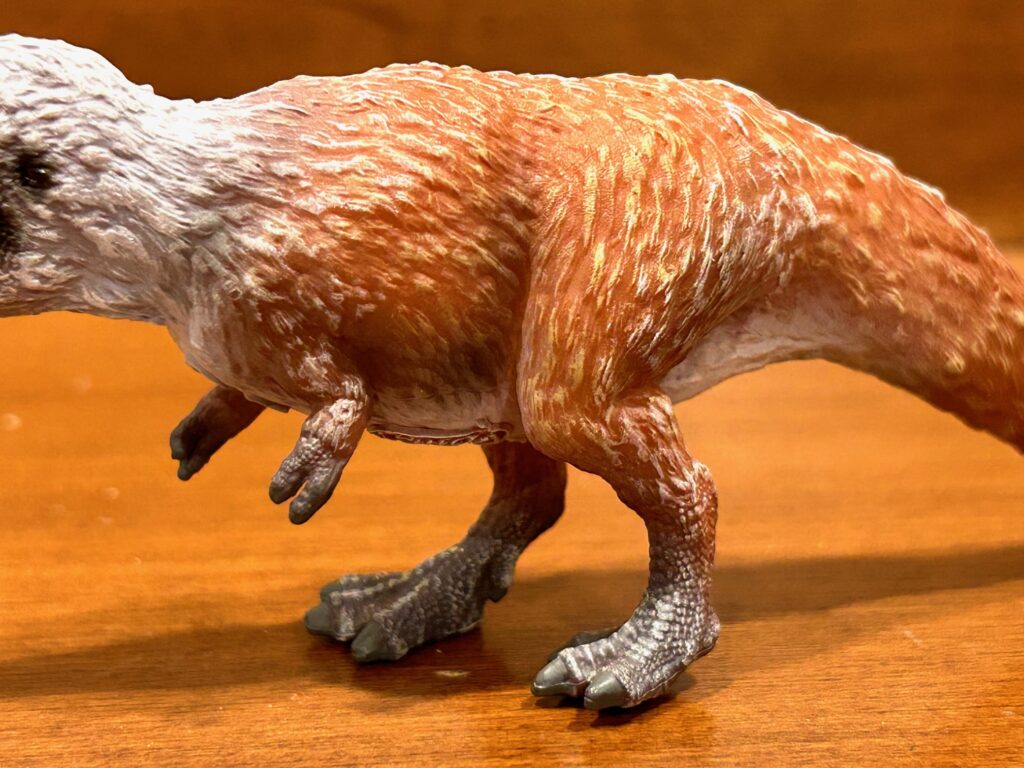
Nanuqsaurus (“polar bear lizard”) is a poorly understood Alaskan tyrannosaurine that lived around 68 to 70 million years ago. Although it is presently known only from fragments of skull and an array of teeth, it recently received a major boost of publicity in 2022 by appearing in the first season of the fabulous Apple TV series Prehistoric Planet. There it was shown as a pack hunter that employed speed, strategy, and sheer diligence to take down a larger Pachyrhinosaurus, much like how the modern Arctic wolf does with muskoxen. And prior to that, it appeared in a 2021 animated YouTube short called “Our Frozen Past,” which is also well worth watching.


CollectA’s 2024 Nanuqsaurus is billed as being in the midst of stalking some prey. To that end, it is posed with its legs bent in a slight crouch, its long tail touching to the ground with the tip raised, and its mouth open. It measures just under 16 cm in length and 5 cm in height, which makes it by far the smallest prehistoric toy in this year’s assortment. Nanuqsaurus has long been described as being one of the smaller tyrannosaurines at around five or six metres in length, and that is how it was depicted in Prehistoric Planet. However, a 2021 study concluded that it was probably closer in size to Albertosaurus, Daspletosaurus, and Gorgosaurus. A 2023 thesis has also concluded that it was a nomen dubium, but I reckon only more fossil remains will settle that debate.



Like many depictions of Nanuqsaurus, this one is covered in a shaggy coat of feathers, even on its belly. The only scaly sections are the muzzle, the hands, and the feet. As in the past, I refuse to go into the whole feathers or no feathers discussion, but there is little question that such ample plumage would indeed be of benefit to a theropod during cold northern winters. The body is mostly painted light brown with beige wash to highlight the plumage. The underbelly is white and the neck is light grey with white wash. The hands and feet are whitewashed grey with solid grey claws and there is more wash applied to the tip of the tail. The head is dark brown with black stripes in front of the glossy black eyes and the mouth is pink with off white teeth.

The unfeathered parts on this toy are covered in fine scales, and the usual rows of scutes on the toes. The feathers are sculpted to appear thick and shaggy, but also relatively streamlined. The tip of the tail features a rather large tuft, which one could imagine to be for display purposes. And finally, the teeth are tiny, but satisfyingly sharp and distinct. Nanuqsaurus lived alongside quite a number of herbivores it could sink its teeth into, including Alaskacephale, Edmontosaurus, and, as already noted, Pachyrhinosaurus. It appears to have been the apex predator of its environment, with the only other known ones being much smaller dromaeosaurs and troodontids.


Judging the accuracy of this toy isn’t really fair given the fragmentary status of Nanuqsaurus, however, it certainly is immediately recognizable as a tyrannosaurid with its deep skull, thick neck, and overall beefy appearance. Indeed, its proportions more strongly resemble those of Tyrannosaurus rex than say, Lythronax or Daspletosaurus. The hands are correctly oriented (which shouldn’t come as any surprise nowadays) and the mouth features lips, so to speak. This is CollectA’s third lipped theropod after the 2021 Megalosaurus and Neovenator, and it will interesting to see the result when they finally tackle a Deluxe-sized large theropod with lips. Who knows, perhaps it will be Tyrannosaurus mcraeensis. I wouldn’t be the least bit surprised.

The CollectA Nanuqsaurus is a petite yet pleasing toy, especially for those who are tyrannosaur fans. It will become available for purchase in the next month or two. Many thanks go out to CollectA for this review sample!

You can support the Dinosaur Toy Blog by making your dino-purchases through these links to Ebay and Amazon.
Trending Products











